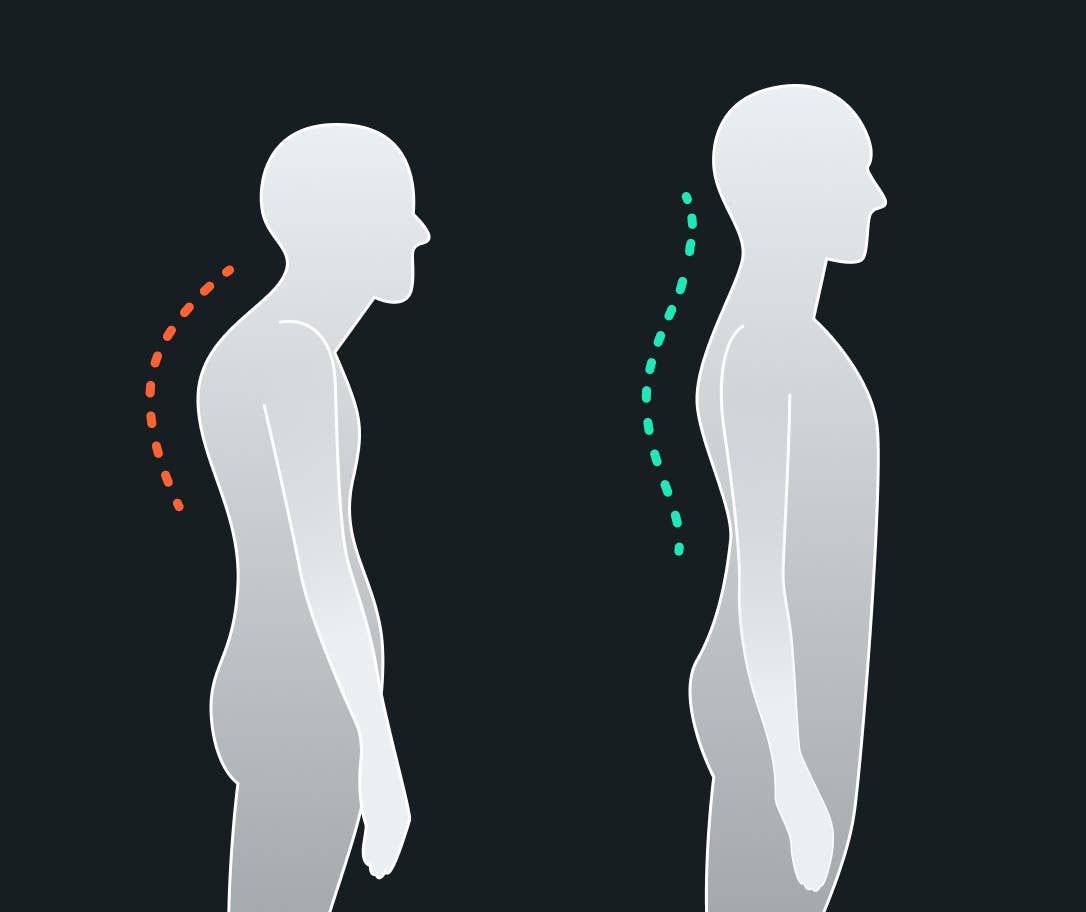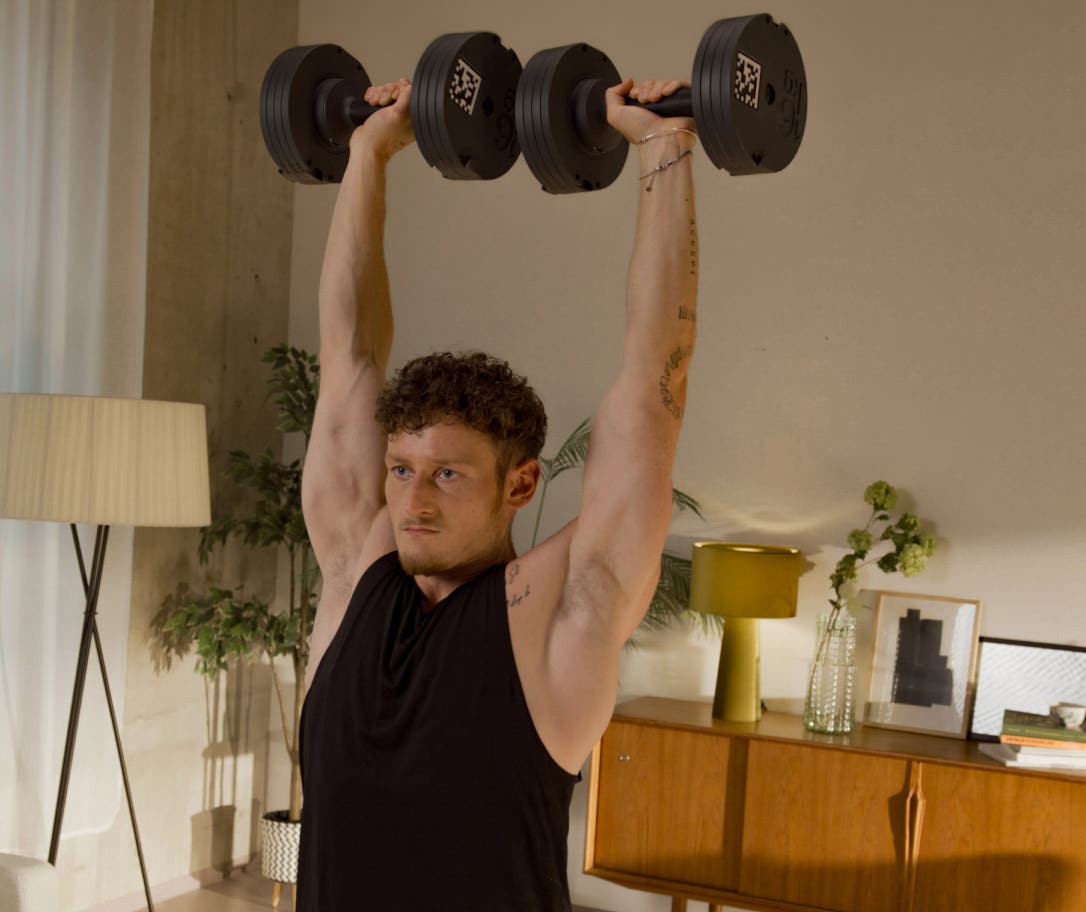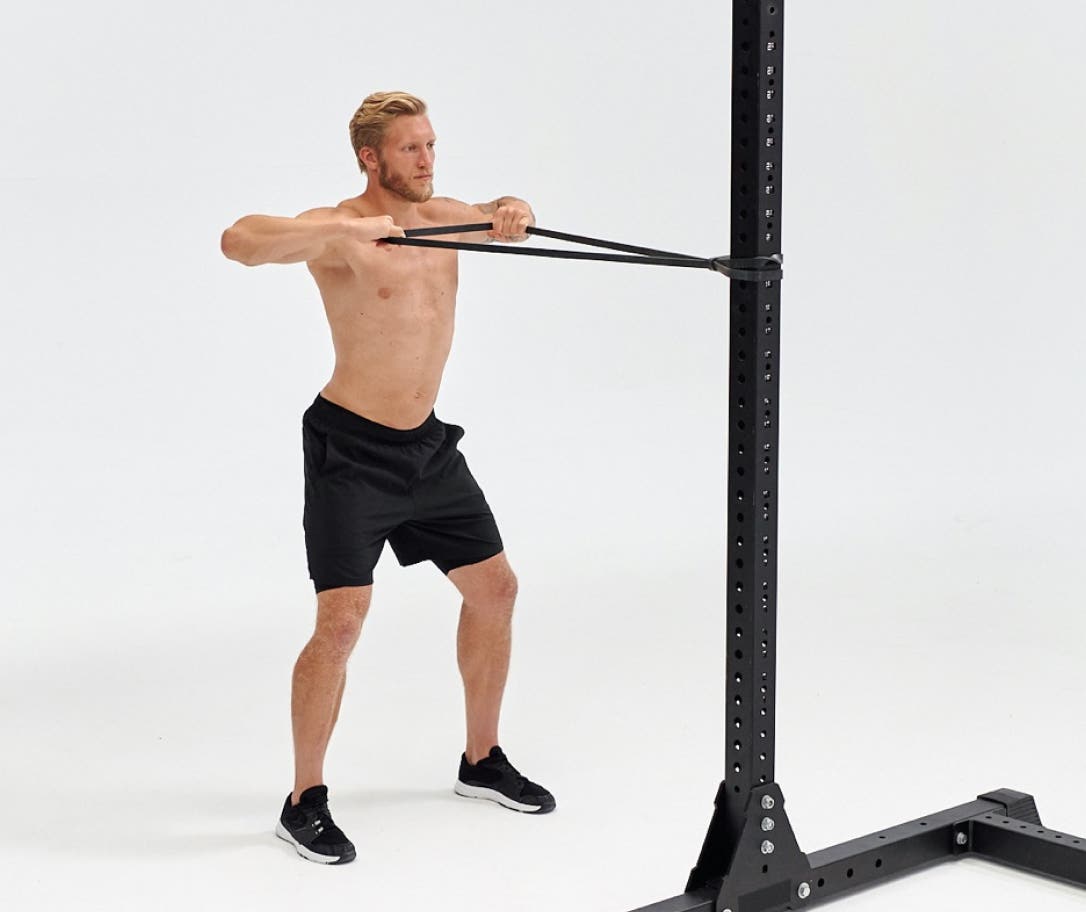Rounded shoulders are a common postural issue where your shoulders slouch forward, altering your appearance and affecting your overall health. This condition often results from daily habits and muscle imbalances, and is commonly associated with upper cross syndrome — a pattern of muscle tightness and weakness in the upper body.
Although it may seem minor, rounded shoulders can lead to discomfort and impact your movement and performance.
What causes rounded shoulders?
Muscle imbalances
Tight chest muscles (pectorals)
The major and minor pectoralis muscles in the chest are used during forward-reaching activities such as typing on a keyboard or reaching for objects.
Over time, these muscles can feel shortened and tight. This tightness pulls on the shoulders, protracting the shoulder blades forward along the ribcage and worsening the rounded posture.
Weak rhomboids
The rhomboid muscles, located between the shoulder blades, are essential for pulling the shoulder blades back and down. When these muscles are weak, they can’t effectively counteract the forward pull of the tight pectoral muscles. This imbalance prevents proper stabilization of the shoulder blades and contributes to a rounded shoulder posture.
Weak middle trapezius muscles (traps)
The middle trapezius muscles also help retract the shoulder blades. When these muscles are weak, they can’t counterbalance the force exerted by tight pectorals. Strengthening these muscles can restore proper shoulder alignment and help reduce the rounded shoulder effect.

Daily habits
Extended computer use
It’s no secret that spending long hours at a computer can negatively impact both your posture and your overall health. And this is even more critical if your ergonomic setup is not up to par such as having a low chair, an improperly positioned screen, or simply poor desk ergonomics.
These can all encourage a forward-leaning posture, which you want to avoid. Habitual slouching causes the shoulders to roll forward, leading to rounded shoulders, and the dominos begin to fall (and not in your favor).
Driving
It’s also possible to develop poor posture during long commutes, especially if the seat is not adjusted properly. Over time, driving with a forward-leaning position can lead to rounded shoulders. And without proper lumbar support and seat alignment, drivers often develop a slouched posture.
Cell phone and tablet use (tech neck)
All that scrolling can put a pretty big toll on your body. Frequently looking down at handheld devices like cell phones and tablets forces your shoulders and head forward. This repetitive motion can lead to rounded shoulders and a forward head posture, creating long-term postural issues – a topic we’ve already discussed at length in our Tech Neck article.
Other factors
Anterior pelvic tilt
An anterior pelvic tilt occurs when the pelvis tilts forward. This misalignment affects the entire spine and shoulders, often leading to a compensatory rounded shoulder posture.1 Correcting the pelvic tilt is important for improving overall posture and reducing the rounded shoulder effect.
Forward head posture
Forward head posture involves the head jutting out in front of the shoulders. This condition frequently goes hand-in-hand with rounded shoulders and further disrupts overall alignment. It places additional strain on the neck and upper back muscles, worsening the rounding of the shoulders.2
Self-confidence
While not a direct cause, rounded shoulders can impact self-esteem or vice versa. Poor posture is often linked to a lack of self-confidence, and individuals with rounded shoulders may feel less assured about their appearance. Improving posture can thus positively affect self-esteem and confidence.

Why you should fix rounded shoulders
Correcting rounded shoulders is crucial for how you feel, look, and move your body. Plus, proper shoulder alignment reduces your risk of injury and contributes to overall health.
Impact on movement and exercise
Many types of physical activities require proper shoulder alignment. For example, when it comes to pushing exercises, having the correct shoulder positioning is key to avoiding unnecessary strain and maximizing results. If your shoulders are rounded, it can limit your range of motion, especially during overhead presses, making these exercises less effective and more likely to cause discomfort or injury.3
Postural integrity
The alignment of the shoulders affects the entire spine. Rounded shoulders can lead to poor spinal alignment, contributing to issues like thoracic kyphosis (an exaggerated upper back curvature) and lumbar discomfort. Maintaining proper shoulder alignment helps preserve the natural curvature of the spine and reduces the risk of secondary issues.4
Examples of exercises requiring proper posture
- Pullups: Proper shoulder alignment allows for full engagement of the upper back muscles.
- Deadlifts: Proper shoulder positioning is crucial for maintaining a neutral spine during Deadlifts. Especially as a beginner, make sure to keep a proper shoulder position to avoid lower back strain.
- Overhead Presses: This exercise requires stable and well-aligned shoulders to press weight overhead effectively. Rounded shoulders can compromise stability and lead to shoulder joint issues, making it difficult to move the weight directly over your head which increases the risk of injury.
- Rowing movements: Exercises like Bent Over Rows require shoulder blade retraction when you bring the shoulder blades together. Rounded shoulders can hinder proper execution and reduce the effectiveness of your movements.
How to fix rounded shoulders
Stretching
- Chest stretch: To counteract tight pectoral muscles, stand in a doorway with your arms at 90 degrees and gently lean forward until you feel a stretch in your chest. This helps alleviate tightness and promotes better shoulder alignment. Another great option could be to add some self-myofascial release using a tennis ball against a wall.
- Biceps stretch: Tight biceps can contribute to rounded shoulders. Extend one arm to the side, rotate your hand backward, and use the opposite hand to gently pull the extended arm back. This stretch relieves biceps tightness and supports shoulder posture.
Strengthening
- Back muscles: Strengthen the rhomboids and middle traps with exercises like Rows, Face Pulls, and Reverse Flies. These exercises help balance the strength of the upper back muscles and improve shoulder alignment.
- Rear shoulder muscles: Strengthen the rear deltoids with exercises like Reverse Flies and Band Reverse Flies. These exercises counteract the forward pull of the pectorals and improve overall shoulder posture.
Other effective exercise examples:
- Face Pulls: Use a resistance band or cable machine to perform Face Pulls. This targets the rear deltoids and upper back muscles, helping to retract the shoulder blades and counteract rounded shoulders.
- Prone Y Raises: Lie face down on an incline bench and lift your arms to form a “Y.” This targets the lower traps and improves shoulder stability.
- Scapular Pushups: In a push-up position, focus on retracting and protracting the shoulder blades. This exercise improves scapular stability and strengthens shoulder muscles.
- Standing Rows: Perform rows with a resistance band or cable machine while standing in a staggered stance for more stability. This engages the upper back and rear shoulder muscles, supporting proper shoulder alignment.

Posture and ergonomics
Self-monitoring
All the strengthening and stretching in the world won’t make a significant impact unless you start becoming aware of your posture.
Regularly check in with yourself and perform a self-analysis of your posture. Is your head leaning forward? Are your shoulders hunching towards your ears or rolling forward? What about your core, is it disengaged?
If you answered yes to any of these questions, take a deep breath in and and lift the top of your head toward the ceiling like a string is pulling you upwards. Exhale deeply and roll your shoulders back and down.
Ergonomic adjustments
Adjust your workstation for better posture. Ensure your chair, desk, and screen are positioned to support a neutral spine and reduce slouching tendencies. Make sure to check out additional suggestions on how to perfect your posture here.
Avoid prolonged sitting:
- Movement breaks: Take breaks every 30-60 minutes to stand up, stretch, and move around. This helps alleviate the strain from sitting and promotes better posture.
- Sitting variation: If you’re seated for a longer period of time, try mixing up your sitting posture. It's still incredibly beneficial to vary your postures even when you're just sitting still.
- Standing desks: Use a standing desk or an adjustable desk that allows you to alternate between sitting and standing. This can reduce the negative effects of prolonged sitting on your posture.
Let’s recap
By addressing the root causes of rounded shoulders and implementing some key strategies for preventing them, you can achieve better posture, enhance your well-being, and foster a healthier lifestyle. Regularly check in with yourself and your body to bring awareness to your posture. This along with targeted exercises and lifestyle adjustments, will support long-term improvements and contribute to a more balanced, ultra-aligned, more confident you.
Sources
[1] Graham, J., Webster, B., & Bennett, D. (2018). Pelvic tilt and its effects on posture. Journal of Orthopaedic & Sports Physical Therapy, 48(3), 204-210.
[2] Morris, T., & Anderson, S. (2019). Postural alignment and its impact on functional movement. Journal of Strength and Conditioning Research, 33(7), 1874-1882.
[3] Cram, J. R. (2016). Muscle strength and postural alignment. Journal of Physical Therapy Science, 28(5), 155-160.
[4] Kendall, F. P., McCreary, E. K., & Provance, P. G. (2014). Muscles: Testing and function with posture and pain. Lippincott Williams & Wilkins.